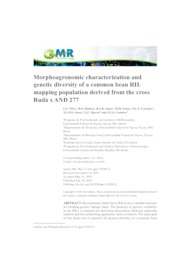Morphoagronomic characterization and genetic diversity of a common bean RIL mapping population derived from the cross Rudá x AND 277.
Morphoagronomic characterization and genetic diversity of a common bean RIL mapping population derived from the cross Rudá x AND 277.
Author(s): SILVA, L. C.; BATISTA, R. O.; ANJOS, R. S. R.; SOUZA, M. H.; CARNEIRO, P. C. S.; SOUZA, T. L. P. O.; BARROS, E. G.; CARNEIRO, J. E. S.
Summary: Recombinant inbred lines (RILs) are a valuable resource for building genetic linkage maps. The presence of genetic variability in the RILs is essential for detecting associations between molecular markers and loci controlling agronomic traits of interest. The main goal of this study was to quantify the genetic diversity of a common bean RIL population derived from a cross between Ruda (Mesoamerican gene pool) and AND 277 (Andean gene pool). This population was developed by the single seed descent method from 500 F-2 plants until the F-10 generation. Seven quantitative traits were evaluated in the field in 393 RILs, the parental lines, and five control cultivars. The plants were grown using a randomized block design with additional controls and three replicates. Significant differences were observed among the RILs for all evaluated traits (P < 0.01). A comparison of the RILs and parental lines showed significant differences (P < 0.01) for the number of days to flowering (DFL) and to harvest (DH), productivity (PROD) and mass of 100 beans (M100); however, there were no significant differences for plant architecture, degree of seed flatness, or seed shape. These results indicate the occurrence of additive x additive epistatic interactions for DFL, DH, PROD, and M100. The 393 RILs were shown to fall into 10 clusters using Tocher's method. This RIL population clearly contained genetic variability for the evaluated traits, and this variability will be crucial for future studies involving genetic mapping and quantitative trait locus identification and analysis.
Publication year: 2016
Types of publication: Journal article
Unit: Embrapa Rice & Beans
Observation
Some of Embrapa's publications are published as ePub files. To read them, use or download one of the following free software options to your computer or mobile device. Android: Google Play Books; IOS: iBooks; Windows and Linux: Calibre.
Access other publications
Access the Agricultural Research Database (BDPA) to consult Embrapa's full library collection and records.
Visit Embrapa Bookstore to purchase books and other publications sold by Embrapa.

